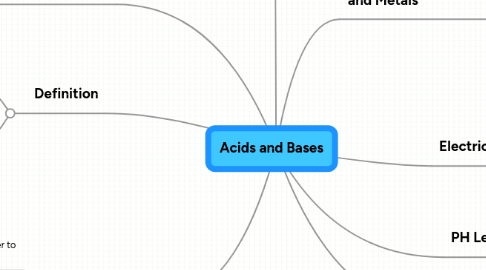
1. Reaction between Acids and Bases (or metal oxides)
1.1. Produces Water + Salt
1.2. Also Known as Neutralisation
1.3. Metal Oxides or hydroxides that dissolve in water are called Alkalis
2. Dissociation
2.1. Acids dissociate in water to give H+ ions
2.1.1. Strength of acid dependent on amount of dissociation in water
2.1.1.1. Strong acid >99% dissociation
2.1.1.1.1. Hydrochloric Acid (HCl)
2.1.1.1.2. Sulfuric Acid (H2SO4)
2.1.1.1.3. Nitric Acid (HNO3)
2.1.1.1.4. Phosphoric Acid
2.1.1.2. Weak Acid <3% dissociation
2.1.1.2.1. Ehanoic Acid (CH3COOH)
2.1.1.2.2. Hydrofluoric Acid
2.1.1.2.3. Citric Acid
2.1.1.3. Amount of dissociation depends on Atomic Structure of Acid
2.2. Bases dissociate in water to give OH Hydroxide ions
2.2.1. Strong Bases
2.2.1.1. Sodium Hydroxide
2.2.2. Weak Bases
2.2.2.1. Aqueous Ammonia
3. Reaction between Acids and Carbonates
3.1. Produces Salt + Water + Carbon Dioxide
3.1.1. Carbon Dioxide is a colourless, odourless gas that gives off a white precipitate when bubbled through lime water
4. Definition
4.1. A base is a metal oxide or a metal hydroxide
4.2. An acid is a substance that produces H+ in water
5. Reaction Between Acid and Metals
5.1. Produces Hydrogen Gas + Salt
5.1.1. Hydrogen Gas is an odourless and colourless gas that extinguishes a lighted splint with a pop-sound
5.2. There will be an explosive reaction if the metal is an Alkali Metal
5.2.1. The lower the element is in group I, the more vigorous the reaction
5.2.2. This is because acids can only react in aqueous form, when they are dissolved in water.
5.3. Unreactive Metals
5.3.1. Silver
5.3.2. Gold
5.3.3. Copper
6. Electrical Conductivity
6.1. Acids can only conduct electricity while in aqueous form
7. PH Level
7.1. Bases have Ph >7
7.2. Acids have Ph < 7
8. Testing
8.1. Litmus Paper
8.1.1. Ph>7
8.1.1.1. Turns blue litmus paper red
8.1.2. Ph<7
8.1.2.1. Turns red litmus paper blue
